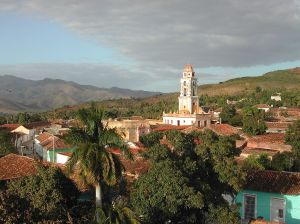
Trinidad is 200 miles away from Havana. It’s an isolated city—surrounded by the dense Escambray Mountains on one side and the Caribbean Sea on the other—in central Cuba. And, along with Santo Domingo, Cartagena, and Old San Juan, it’s one of the best-preserved colonial cities in the Caribbean.
The city’s wealth came from the sugar trade and the hard work of slave labor. It created Spanish-style buildings—pastel-colored houses with wrought-iron grills, red-tiled roofs, and wooden shutters—plus cobblestone streets and wide plazas. Plaza Mayor is the heart of the city. It’s surrounded by churches and old mansions that have been turned into museums. Climb the wooden stairs in the Church of the Holy Trinity for views over the entire town. Visit the Museum of the War Against the Bandits in a former convent, and the galleried courtyard and the original frescoes at the Municipal History Museum. Check out the 1950s Buicks and Chevys parked on the side streets. Buy handmade linens and tablecloths at the market.
![Photo: Ivan2010 (Own work) [CC-BY-SA-3.0 (http://creativecommons.org/licenses/by-sa/3.0)], via Wikimedia Commons](https://travelcravingsdotcom1.files.wordpress.com/2014/01/1024px-valle_de_los_ingenios-_trinidad-cuba.jpg?w=300&h=199)
Just return to Trinidad later in the evening. The salsa music will guide you back to Plaza Mayor, where Casa de la Música is now set up. The al fresco dance space has live music, beer, and people who know how to move. You’re hesitant, at first. But eventually, you make your way to the dance floor. You may not know the steps and your hips seem to move in the wrong direction, but it doesn’t matter. You’re laughing and dancing like it’s 1952.
As you expected, you’ve fallen in love with Cuba and its beautiful architecture, gorgeous landscape, and welcoming people. It shouldn’t have taken this long.